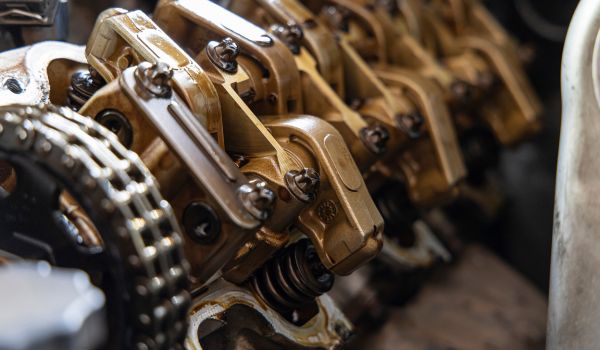The Suzuki engine is a key component in the Suzuki brand, and its year of manufacture is determined through its unique engine code. This code identifies the engine’s model, specifications, and production year, providing valuable information for mechanics, enthusiasts, and owners. Understanding the engine’s year is crucial for sourcing the correct components, understanding potential recalls, and complying with emissions regulations. Understanding the intricacies of Suzuki engine codes is essential for navigating the coding system, ensuring optimal performance and compliance with emissions regulations. By understanding the engine’s year, readers can make informed decisions about their vehicle’s performance and service intervals.
Understanding Suzuki Engine Codes Basics
Suzuki engine codes are alphanumeric designations that provide crucial information about an engine’s specifications, including model, displacement, and production year. These codes reveal details about the engine’s configuration, generation, and design features. Familiarity with these coding systems is essential for mechanics and enthusiasts, especially when sourcing parts or conducting maintenance. Decoding these engine identifiers helps verify the authenticity and history of a vehicle, assess reliability for potential buyers, and trace service records and modifications. Understanding Suzuki engine codes not only aids in technical comprehension but also enhances informed decision-making in the automotive realm.
Learn How Engine Codes Indicate The Manufacturing Year Of Suzuki Engines.
Suzuki engine codes provide a comprehensive understanding of the engine’s lifecycle, with the manufacturing year embedded within the code. This year of production is crucial for evaluating vehicle condition and considering modifications. Understanding Suzuki’s coding guide helps identify the engine’s age, fostering better communication between enthusiasts, mechanics, and parts suppliers. Correct interpretation of engine codes streamlines the process of finding compatible replacement parts and ensures maintenance work is performed with correct specifications. This understanding enhances vehicle performance and overall ownership experience.
Locating Your Suzuki Engine Code
Suzuki vehicles typically have engine codes located in specific locations, such as the engine block, cylinder head, or front side of the engine. For some models, the code may be on a label or plate affixed to the vehicle, such as in the engine bay or near the coolant reservoir. Consult the vehicle’s service manual for precise guidance on the location. Accurate reading of the engine code is crucial to avoid misinterpretations. After obtaining the correct code, enthusiasts and mechanics can use Suzuki’s official documentation or online resources to decode it effectively. This helps determine the engine’s production year, specifications, and compatibility with other components, facilitating informed decisions regarding repairs and upgrades.
Find The Specific Location Of The Engine Code On Your Suzuki Vehicle.
The engine code in Suzuki vehicles is typically located on the engine block, often on a surface accessible, depending on the specific model and year. It may be on the front of the engine, near the cylinder head, or alongside the oil filter. For some models, a label or sticker may be prominently displayed in the engine compartment, containing vital information about the engine specifications. The exact placement of the engine code can vary significantly between different Suzuki models, making it advisable to refer to the owner’s manual or service guide for model-specific details. Consulting a qualified technician can provide further clarity and assurance in accurately retrieving the engine code from your Suzuki vehicle.
Decoding The Engine Number System
Suzuki vehicles are equipped with an engine that is identified by an engine number system, which provides crucial information about the engine’s specifications and origin. The engine number, typically composed of alphanumeric characters, can reveal details like engine displacement, construction features, and production year. Understanding these codes is crucial for enthusiasts, mechanics, and those involved in maintenance or restoration of Suzuki vehicles. The engine code also offers insights into compatibility with other parts and systems, such as performance characteristics or emissions standards. Decoding the engine number helps make informed decisions regarding repairs, upgrades, and replacement components, ensuring optimal vehicle performance and longevity.
Understand The Structure Of Suzuki Engine Numbers For Accurate Year Identification.
Suzuki engine numbers are a series of letters and numbers that provide detailed information about the engine’s model and manufacturing details. The initial letters often represent the engine series, while subsequent numbers indicate the engine’s displacement and production sequence. This systematic arrangement ensures precise identification of the engine’s specifications and the year of manufacture. Accurate year identification is crucial for parts replacement and maintenance schedules. Cross-referencing the engine number with Suzuki’s internal coding system or databases allows for the determination of production year and any modifications made during the production cycle.
Cross-Referencing Codes With Production Years
Suzuki’s engine lineage and specifications are crucial for ensuring compatibility and performance. A detailed understanding of the specific engine can help source appropriate parts for maintenance or restoration projects. Utilizing cross-referencing methods allows for efficient navigation through Suzuki’s records, confirming the production year tied to a specific engine code. This process enhances the accuracy of repairs and upgrades, and provides insights into potential recalls or service bulletins associated with specific engine batches. Accurate engine identification is essential for preserving the integrity and performance of Suzuki vehicles over time.
Utilize Tables To Match Engine Codes With Corresponding Suzuki Production Years.
Suzuki’s engine identification system uses a streamlined approach by aligning engine codes with their respective production years. This data-driven system allows for quick reference and comparison, reducing errors in part selection and enhancing maintenance efficiency. The tables also provide insight into the evolution of Suzuki’s engine technology, highlighting patterns and changes across different models. This comprehensive knowledge aids in making informed decisions regarding modifications or restorations, reinforcing the importance of historical context in automotive maintenance. By utilizing these resources, Suzuki ensures optimal functionality and respects the heritage of their engineering.
Importance Of Accurate Year Identification
Suzuki engines require accurate identification of their production year for repair, restoration, and parts replacement. Each year may introduce variations in engine design, performance characteristics, and compatibility with components, affecting repair efficiency and longevity. Misidentification could lead to incorrect parts, suboptimal performance, increased wear, or even engine failure. Accurate year identification also aids in assessing warranty claims, recalls, and compliance with regulatory standards. Different years may correspond with varying compliance requirements or safety features, impacting the overall value and legality of a vehicle. For collectors and restorers, maintaining a vehicle’s historical authenticity is paramount, and accurate year identification plays a vital role in preserving its legacy.
Ensure Proper Maintenance And Parts Replacement By Knowing Your Suzuki Engine’s Manufacturing Year.
Maintaining your Suzuki engine in optimal condition hinges on recognizing its manufacturing year, as this knowledge plays a pivotal role in ensuring that maintenance schedules and parts replacements are executed correctly. Each engine year may feature unique specifications, tolerances, and design elements that can influence the performance and reliability of the vehicle. By accurately identifying the engine’s production year, technicians can refer to the appropriate service manuals, ensuring that all maintenance procedures align with the correct protocols. This attention to detail minimizes the risk of errors during servicing and extends the lifespan of the engine through appropriate care.
Understanding the manufacturing year of a Suzuki engine is crucial for sourcing the correct replacement parts and maintaining the integrity of vehicles. Incompatible components can lead to mechanical issues, reduced performance, and increased susceptibility to breakdowns. Prioritizing knowledge of the engine’s production year enhances safety, reliability, and overall satisfaction with the vehicle’s performance. Identifying the engine code and alphanumeric indicators denoting the manufacturing year helps individuals ensure they are sourcing the correct parts and maintaining the integrity of their vehicles. This knowledge not only aids in proper maintenance and repairs but also enhances the overall ownership experience. As Suzuki continues to innovate, being informed about their engines will empower owners to make informed decisions, preserving their vehicles’ performance and value for years to come.
FAQ
Here’s a list of 5 questions that can help in identifying the year of a Suzuki engine using the engine code:
What Is The Significance Of The Engine Code In Determining The Manufacturing Year Of A Suzuki Engine?
The engine code of a Suzuki engine is crucial for determining its manufacturing year, providing information on the model and year of manufacture. This information is essential for maintenance, repairs, and compatibility with vehicle parts. Suzuki may update engine designs or specifications over different manufacturing years, making the engine code a vital reference for both manufacturers and consumers.
How Can I Decode The Alphanumeric Characters In A Suzuki Engine Code To Ascertain The Engine’s Production Year?
Suzuki engine codes are decoded using an alphanumeric string, consisting of letters and numbers. The first character indicates the engine family, while the subsequent digits usually denote the production year. For example, a number from 0 to 9 corresponds to the last digit of the production year. Consult a Suzuki engine code reference guide for specific interpretations and verify with official Suzuki documentation for accuracy.
Are There Specific Patterns Or Formats In Suzuki Engine Codes That Indicate The Decade Or Year Of Production?
Yes, Suzuki engine codes often follow specific patterns that can indicate the decade or year of production. Generally, the engine code includes a combination of letters and numbers, where the letters typically denote the engine type or series, while the numbers may indicate the displacement or production sequence. Additionally, Suzuki has used certain prefixes or suffixes in different decades, helping enthusiasts and mechanics identify the engine’s era. However, decoding these codes accurately may require a reference guide specific to Suzuki models, as conventions can vary over time.
Where Can I Find A Comprehensive Database Or Chart That Correlates Suzuki Engine Codes With Their Corresponding Production Years?
You can find a comprehensive database or chart correlating Suzuki engine codes with their production years on automotive forums, Suzuki enthusiast websites, or specialized databases like Suzuki’s official site. Websites such as Suzuki Forums, Car Parts websites, and Wikipedia can also provide useful information. Additionally, automotive repair manuals and databases like Haynes or Chilton may contain this information. For a detailed search, consider visiting online communities or groups dedicated to Suzuki vehicles.
What are some common mistakes to avoid when trying to identify the year of a Suzuki engine based on its engine code?
Common mistakes in identifying the year of a Suzuki engine based on its engine code include misreading the code format, overlooking the code’s location, confusing similar codes across models, and failing to reference correct model year charts. Verifying the specific code against reliable Suzuki documentation and cross-checking with a trusted source is crucial for accurate identification and avoiding errors.








